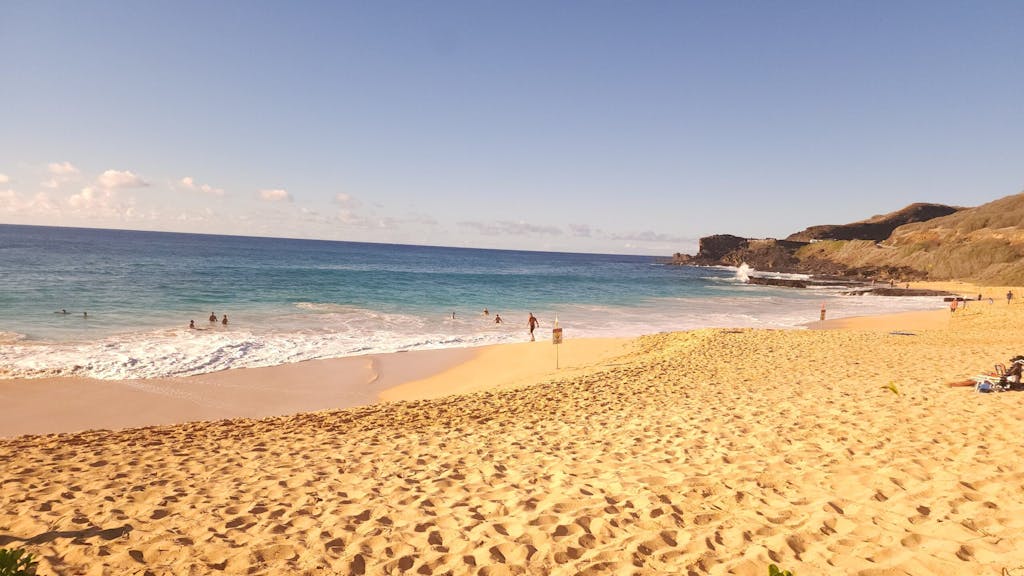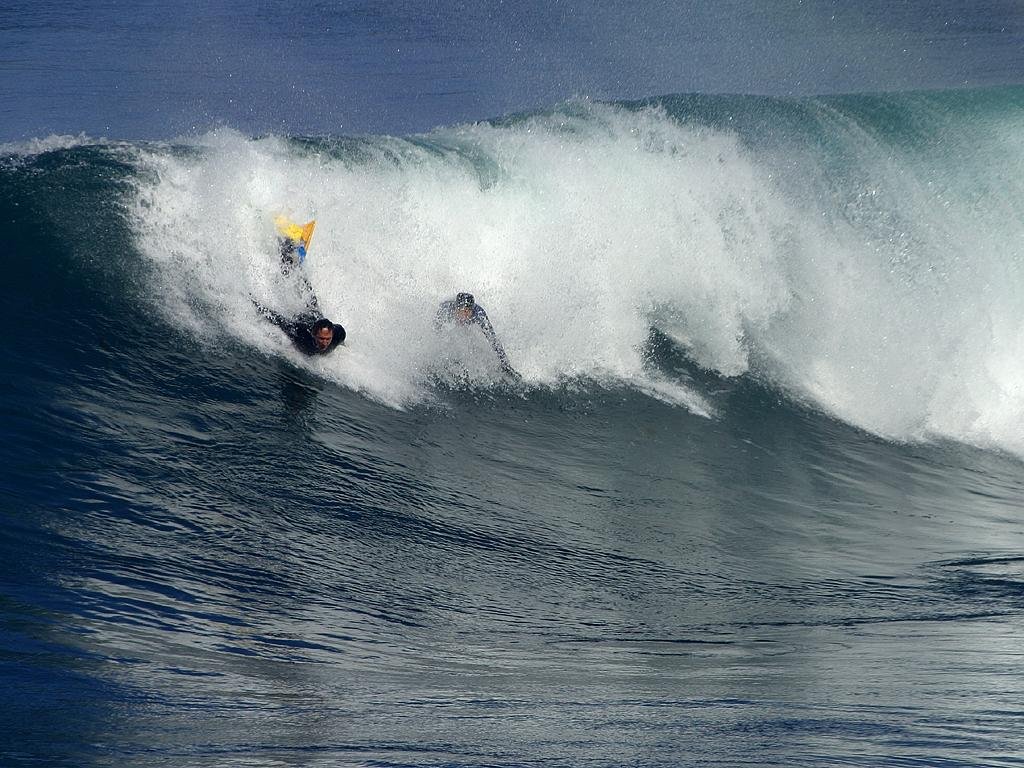At Oahu’s southeastern tip is Sandy Beach, with a popular shorebreak famous for its size and raw power. Locals love “Sandy’s” for its waves and easy accessibility, and visitors are attracted to its broad, white sands and crystal clear water.
Two lifeguard towers, freshwater showers, bathroom facilities, expansive grass fields, and nearby food trucks make Sandy’s an ideal spot for an all-day picnic at the beach.
But the tranquil surroundings of Sandy Beach belie the very real dangers posed by the surf that pounds the shore. It has long been known as “Broke Neck Beach” and the broken neck capital of the world. Lifeguards here are busy year-round, mostly thanks to swimmers and surfers who are overconfident in their ability to navigate its monstrous shorebreaks.
What to Do at Sandy Beach Oahu
Before we outline the different breaks of Sandy Beach, we’ll share this critical warning: these are not friendly waters for anyone except expert-level surfers and bodyboarders.
But it could be a nice place to visit if you enjoy watching surfers. There is a vast stretch of soft sand that’s nice for sunbathing, several tables for having a scenic picnic, and good conditions for flying a kite. Just don’t plan to swim here – head back toward Waikiki or up to Kailua if you want some time in the water.
The Many Surf Breaks of Sandy Beach
There are several surf breaks that make up this one Oahu beach, each with its own distinct characteristics. None of them are for beginners. In fact, even if you consider yourself a strong swimmer and bodyboarder, you still should stay out of the waters here.
It can be tempting to shrug off this advice since you’ll see teens and preteens playing in the water with apparent ease. But these kids have years and years of experience surfing Hawaii’s unpredictable waters. Plus, most anyone who grew up playing at Sandy Beach has some kind of “broke neck” horror story – either something they saw or their own near-miss.

Still, if you’re out watching the surfers at Sandy’s, it’s fun to know the names of the different spots, and how powerful these waves can get. So we’re breaking down the shorebreaks at this Oahu Beach just for you.
Facing the ocean, from left (east) to right (west), the breaks line up as follows.
1. Full Point
At the eastern end of Sandy Beach Park is Full Point, an offshore reef break popular with longboarders. It’s a couple of hundred yards from the beach and should only be attempted by fit, experienced surfers.
Sandy Beach lifeguards are among the best in the world, but the sheer distance of Full-Point from the nearest lifeguard tower means that it takes at least a minute for them to reach anyone who gets into trouble there.
2. Half Point
Half Point is closer to shore with its own unique dangers. Here, you’ll find a harrowingly shallow reef where the wave breaks over. That makes it a short, hollow tube wave that’s popular with body-boarders and more intrepid shortboarders. At lower tides, the reef goes dry. And it’s razor-sharp. Half-Point breaks both left and right, with the right ending in a channel and the left running into the shorebreak.
3. Pipe Littles
Half-Point feathers into Pipe Littles. This little spot at Sandy Beach is named for its resemblance to the famous Banzai Pipeline on the North Shore. Here, you’ll see shortboard surfers vying for a position in a punishing closeout shorebreak tube.
4. Cobbles
The Pipe Littles waves break at Cobbles. Stepping (or crashing) into Cobbles will reveal the reason for its name. This area of the beach collects bits of loose, white coral that look and feel like cobblestones. Landing on the beach here will feel like landing on hard gravel — ironic when you consider they named this place Sandy Beach.
5. Middles
The main break at Sandy’s is Middle Peak or just Middles. South swells focus on this part of the beach, where the shorebreak is the biggest. There is palpable drama in the air as towering sets march toward the sand and bodyboarders and bodysurfers scratch for the horizon. When the surf is up, people on the beach can feel the sand rumble as waves crash ashore. The sand slopes steeply into the water in this part of the beach, sometimes causing spectacular backwash that launches riders onto practically dry sand.
6. Gas Chambers
Surfers call the western end of Sandy Beach Gas Chambers, or just Chambers. This is the shallowest part of the beach and perhaps the most dangerous. The shallow water makes for the hollow tube waves that give Gas Chambers its name. Rare is the rider that makes it out of a tube here. This shore break is named after a similar spot on the North Shore.
7. Last Man’s
Last Man’s is the last rideable part of the beach before it gives way to lava rock and reef. Here, water breaks onto a broad lava rock slab that may or may not be covered with a thin layer of sand, depending on the tide. As you continue on toward the west past Sandy Beach, you’ll reach Halona Blowhole and Halona Beach, which you’ll recognize from the film “From Here to Eternity.”
Your Visit to Sandy Beach Oahu
We outlined these popular surf spots so you can better enjoy watching the experts navigate the waves. As a visitor, you should stay out of the water here and definitely consult with lifeguards before you go into the water at any beach.
For your trip to Sandy Beach, plan for a nice time on shore, taking in the sights and sounds of a popular surf spot as you enjoy the amazing weather of Oahu’s southeastern shore.




